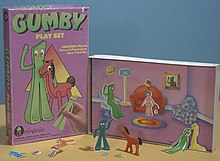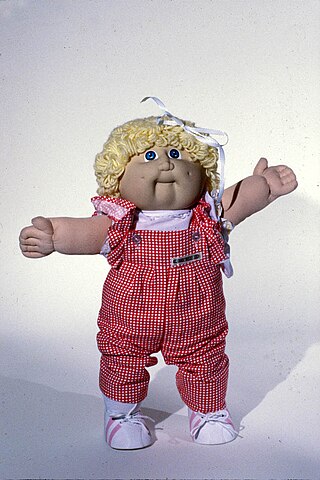
Cabbage Patch Kids are a line of cloth dolls with plastic heads first produced by Coleco Industries in 1982. They were inspired by the Little People soft sculptured dolls sold by Xavier Roberts as collectibles. The brand was renamed 'Cabbage Patch Kids' by Roger L. Schlaifer when he acquired the exclusive worldwide licensing rights in 1982.
An action figure is a poseable character model figure made most commonly of plastic, and often based upon characters from a film, comic book, military, video game or television program; fictional or historical. These figures are usually marketed toward boys and adult collectors. The term was coined by Hasbro in 1964 to market G.I. Joe to boys.

Playmobil is a German line of toys produced by the Brandstätter Group, headquartered in Zirndorf, Germany. The signature Playmobil toy is a 7.5 cm (3.0 in) tall human figure with a smiling face. A wide range of accessories, buildings and vehicles, as well as many sorts of animals, are also part of the Playmobil line.
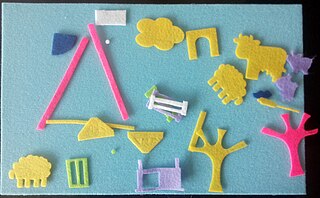
Fuzzy-Felt is a simple fabric toy intended for young children, first sold in 1950. The toys consist of a flocked backing board onto which a number of felt shapes are placed to create different pictures. Felt pieces can be simple silhouettes or more detailed printed shapes. For a farmyard scene, for example, auxiliary pieces would typically be cows, sheep, chickens, horses, cats, dogs, a farmer, and a tractor. Other scenes might include hospitals, pets, and vehicles. Fuzzy-Felt is for children over the age of three years, as the pieces may present a choking hazard.
The Mego Corporation is an American toy company that in its original iteration was first founded in 1954. Originally known as a purveyor of dime store toys, in 1971 the company shifted direction and became famous for producing licensed action figures, celebrity dolls, and the Micronauts toy line. For a time in the 1970s, their line of 8-inch-scale action figures with interchangeable bodies became the industry standard.
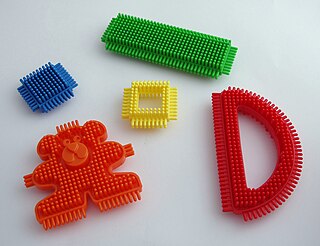
Stickle Bricks are a construction toy primarily intended for toddlers invented by Denys Fisher in 1969. The brand is owned by Hasbro, and as of 2016 is sub-licensed to Flair Leisure Products plc.
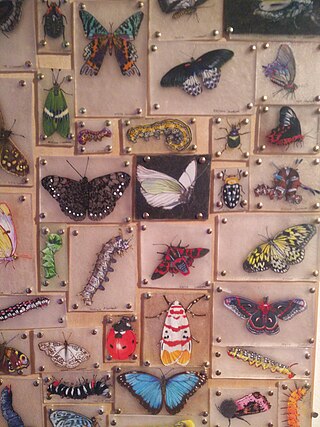
Shrink art, Shrinky Dinks, or Shrinkles is a toy and activity kit consisting of sheets of polystyrene which can be cut with standard household scissors. When heated, the cut shapes become about nine times thicker while their horizontal and vertical dimensions reduce to about one-third the original size, resulting in hard, flat forms which retain their initial color and shape. They reached the height of their popularity in the 1980s and are still available from retailers. They can be used for a variety of things like charms and pins. Most sets are pre-printed with outline images of popular children's characters or other subjects, which are then colored in before baking.
Thingmaker, also called Creepy Crawlers, is an activity toy made by Mattel, beginning in 1964. The toy consists of a series of die-cast metal moulds resembling various bug-like creatures, into which is poured a liquid chemical substance called "Plasti-Goop", which comes in assorted colours. The mould is then heated to about 390 °F (199 °C) in an open-face electric hot plate oven. The Plasti-Goop is cured by the heat, and when cooled forms semi-solid, rubbery replicas which can be removed from the mould.
Polly Pocket is a toy line of dolls and accessories first founded and designed by Chris Wiggs in 1983 and licensed by Bluebird Toys from 1989 until both entities/properties were acquired by Mattel in 1998.
The history of Lego began in 1932 in the carpentry workshop of Ole Kirk Christiansen, a Danish carpenter who initially produced furniture but later started making wooden toys. The company was named "Lego" in 1934, a contraction from the Danish phrase "leg godt", meaning "play well".

Schleich is a German producer of hand painted toy figurines and accessories. The company is headquartered in Schwäbisch Gmünd, Germany. In 2020, the group employed 440 people and generated sales of 188.7 million euros. Half of the sales are generated outside of the German domestic market, and Schleich branded play figurines and playsets are sold in over 60 countries. In 2022, the company sold a total of approximately 40 million figurines.

Ideal Toy Company was an American toy company founded by Morris Michtom and his wife, Rose. During the post–World War II baby boom era, Ideal became the largest doll-making company in the United States. Their most popular dolls included Betsy Wetsy, Toni, Saucy Walker, Shirley Temple, Miss Revlon, Patti Playpal, Tammy, Thumbelina, Tiny Thumbelina, and Crissy. The company is also known for selling the Rubik's Cube.
For the real-life aircraft known as a Vertibird, see Tiltrotor

Between 1978 and 1985, Kenner produced and sold action figures based on the Star Wars franchise. From a line of over 100 unique toys, a total of more than 300 million units were sold during their original run. Kenner began producing new Star Wars action figures in 1995.
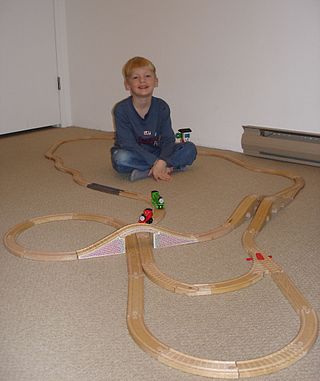
Merchandise for the Thomas & Friends franchise has been produced to capitalize on the success of the television series Thomas & Friends. Whilst merchandise was produced alongside due to the popularity of the first of The Railway Series by the Rev. W. Awdry since 1945, and the original broadcast of the television series in 1984 in the United Kingdom, large numbers of manufacturers have sought to produce Thomas-branded items after the television series was broadcast in the United States and Japan.

Funko Inc. is an American company that manufactures licensed and limited pop culture collectibles, best known for its licensed vinyl figurines and bobbleheads. In addition, the company produces licensed plush, action figures, apparel, accessories and games. Founded in 1998 by Mike Becker and Claudia Becker, Funko was originally conceived as a small project to create various low-tech, nostalgia-themed toys. The company's first manufactured bobblehead was of the Big Boy mascot, the well-known restaurant advertising icon.
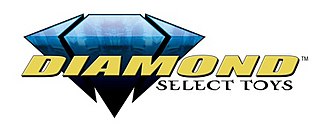
Diamond Select Toys was founded in 1999 by sister company Diamond Comics Distributors to create collectibles for adult collectors, and has since licensed a variety of pop culture properties, including Marvel Comics, Star Wars, Star Trek, Transformers, Ghostbusters, Halo, G.I. Joe: A Real American Hero, Buffy the Vampire Slayer, Indiana Jones, Battlestar Galactica, 24, The Muppets and Back to the Future. While they have made collectibles in numerous product categories, including action figures, plush, banks, busts, statues and prop replicas, many of their licensed properties are released in the form of Minimates mini-figures.
Moose Toys is an Australian-owned toy design, development and distribution company founded in 1985. Moose is headquartered in Australia, has over 600 staff and distributes to over 50 countries.
University Games Corporation is an American game company, based in San Francisco, California.
